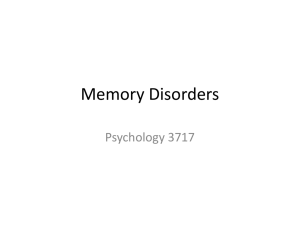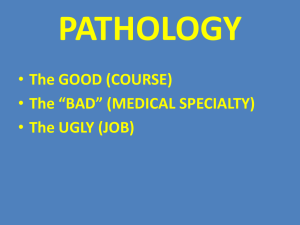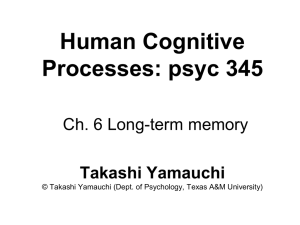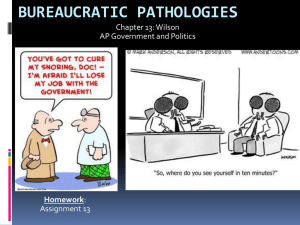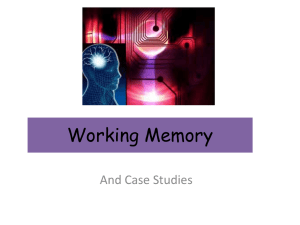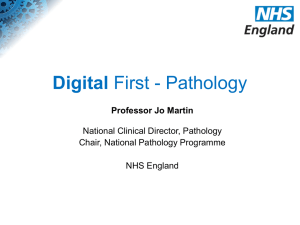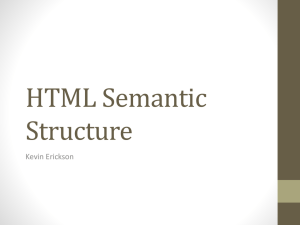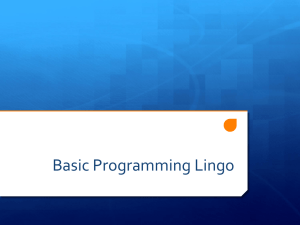YTISHBDSYTEA - CELTA - Université Paris
advertisement
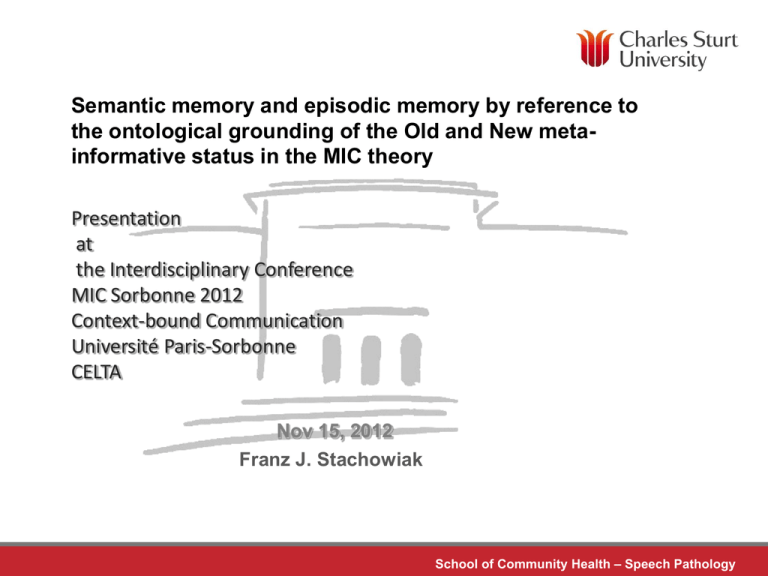
Semantic memory and episodic memory by reference to the ontological grounding of the Old and New metainformative status in the MIC theory Presentation at the Interdisciplinary Conference MIC Sorbonne 2012 Context-bound Communication Université Paris-Sorbonne CELTA Nov 15, 2012 Franz J. Stachowiak School of Community Health – Speech Pathology Attention-Getter School of Community Health – Speech Pathology Goal of the talk This talk attempts to demonstrate how neuropsychological findings and models can contribute to further elaborate the MIC theory and thus, in turn, provide a basis to explain pathological data. Such models are required for diagnostics and intervention in speech pathology. School of Community Health – Speech Pathology Outline Language disorders vs. cognitive communication disorders Information processing and linguistic pragmatics New and old information in language processing Episodic and semantic memory An integrated model of pragmatic competence (based on MIC theory) A pilot study School of Community Health – Speech Pathology Pragmatic competence The pragmatic competence of a speaker/listener consists of his/her ability to produce and understand verbal expressions whose predicational structure exhibits meta-information which draws attention to the “subject” of the message. The centres of attention are related to the world (“ontology”, “encyclopaedic knowledge” etc.) via the semantic system. One of the main features of verbal communication is that the information to be conveyed is treated as new or old, the newness or oldness being its meta-informative status depending on the discourse strategies (i.e. the pragmatic attitude) of the speaker. (A. and H. Wlodarczyk, 2010). School of Community Health – Speech Pathology Cognitive CommunicationDisorders Definition from: Preferred Practice Guideline for Cognitive-Communication Disorders · Approved September 2002 College of Audiologists and Speech-Language Pathologists of Ontario Cognitive-communication disorders are disturbances of communicative competence (listening, speaking, reading, writing, conversation and social interaction) which result from underlying cognitive impairments (attention, memory, organization, information processing, problem solving, and executive functions). These disorders are distinct from other neurological communication disorders (e.g., aphasia, dysarthria etc.). Cognitive-communication disorders are commonly associated with traumatic brain injury (TBI) but can also occur as a result of other acquired brain injuries (ABI) such as haemorrhages, stroke, meningitis, encephalitis, anoxia, or tumours. School of Community Health – Speech Pathology Right Hemisphere Language and Communication Abusamra contin., p. 74 School of Community Health – Speech Pathology Right Hemisphere Language and Communication Abusamra contin., p. 75 Example School of Community Health – Speech Pathology Schizophasia Similarly schizophasia is characterized by a problem to maintain attention to relevant information; patients often produce chains of associations to what was said in the context and drift away from the topic. The following example from Ian Thompson (2001: see also: discourse in neuropsychiatry) shows this typical kind of drifting away from the centre of attention: “Parents are people that raise you. Anything that raises you can be a parent. Parents can be anything, material, vegetable or mineral, that has taught you something. Parents would be the world of things that are alive, that are there. Rocks, a person can look at a rock and learn something from it, so that would be a parent.” School of Community Health – Speech Pathology The distribution of new and old information One of the main features of verbal communication according to the ASMIC theory (A. and H. Wlodarczyk, 2010) is that information is treated as new or old, the newness or oldness being its meta-informative status depending on the discourse strategies (i.e. the pragmatic attitude) of the speaker with respect to the addressee of the utterance. “Old and new meta-informative status may be grounded either in discourse (anaphora/cataphora), beliefs (Known/unknown) or ontological knowledge (referential grounding)” School of Community Health – Speech Pathology The distribution of new and old information: an example “In the following utterance: “It is Albert Einstein who discovered the law of Relativity.” the subject Albert Einstein is focalized as a new chunk of information contrasting with what is treated as the old information (or presupposition): “(there is somebody who) discovered the law of Relativity”.” (p.4). Although Albert Einstein is one of the best known persons worldwide, in this context the reference to him gets the status of new information. To use the figure-ground metapher, Albert Einstein is attributed figure-status on the ground of the information about the discovery of Relativity. The speaker assumes that the addressee has connected the act of discovery to another person or does not know at all, who was the discoverer of Relativity. Yet, the speaker attributes the knowledge to her/him that she/he knows about the fact of the discovery. School of Community Health – Speech Pathology Episodic and semantic memory Interestingly, the discovery of Relativity was an event in Albert Einstein´s life, which must have left strong traces in his and his colleagues´ episodic memories, but the important fact that it happened became general knowledge, i.e. semantic knowledge of billions of traditionally educated people. In contrast, most private events of Einstein´s life are not known to the public. The fact that he got divorced from his wife Mileva in order to marry his cousin Elsa, cannot be considered as general knowledge. However, if this information is predicated to his name, new epistemic knowledge is produced. Thus information from episodic and semantic memory get combined. School of Community Health – Speech Pathology Classification of Memory Types School of Community Health – Speech Pathology Episodic memory as a source of information Episodic memory pertains to the learning, storing and retrieval of autobiographical facts, i.e. unique personal experiences, to events in our lives, occurrences, careers, encounters, talks with others, accidents, etc. The question “Where were you and what did you do when Sep 9, 11 happened?” is a question about an episode in one´s personal life. Information in Episodic Memory Space—Physical layout of the place(s) Actor—Range of people involved Activity—A set of related activities that occur Object—The physical things that are present Act—Single actions people undertake Event—Activities that people carry out Time—The sequencing of events that occur Goal—Things that people are trying to accomplish Feeling—Emotions felt and expressed School of Community Health – Speech Pathology Semantic memory as a source of information Semantic memory, although it is like episodic memory a form of long term declarative (factual) memory , stores knowledge that can be learnt independently of reference to time and place. According to the classical view it is not relevant where and when it was learnt. The fact of the discovery of Relativity can be learnt at school. “Encyclopedic knowledge of information such as the features of objects (e.g. apples are usually red), categories (e.g. oranges and bananas are both types of fruit), historical events, mathematical tables, cognitive maps, and similar types of information are considered to be stored in semantic memory systems of the brain” (Dickerson and Eichbaum, 2010:87). Semantic memory in this encompasses more than linguistics semantics. School of Community Health – Speech Pathology Clinical evidence for the relative autonomy of different types of memory Certain brain lesions can lead either to impairment of episodic or semantic memory. Bilateral lesions of the medial temporal lobe (including the hippocampus) can lead to a complete loss of episodic memory whereas semantic memory remains largely intact. See following case description. School of Community Health – Speech Pathology Loss of episodic memory: a case A 42 year old teacher of mathematics and physics had suffered a heart arrest followed by an ischemic thalamic lesion. He suffered from a severe amnesia. He was forced to believe others that he was married, had children, had built a house, had worked at a particular school etc. as all of that information was lost from his memory. He had no aphasia and showed no semantic disorder, but when asked what a chicken is, he was very uncertain whether it is a kind of bird. The sentence “Chickens lay eggs” sounded normal to him. In a pizzeria he noted in an astonished way: “Ah, that´s a Pizza”. When eating it he said that he knows the taste. He was able to demonstrate – after some preparation – that he could still teach mathematics. His behaviour showed the typical demeanour of a teacher, and he understood the contents well enough to make them plausible to the students. He understood the rules of soccer and watched matches on TV, but did not know any player and could not remember any important matches. In comparison to the deep loss of his episodic memory (except for a short period in his childhood), his semantic memory and world knowledge was intact to such an extent that he could lead a rather independent life. School of Community Health – Speech Pathology Interaction between the types of memory Recent models assume a rather complex feedback system between episodic and semantic memory. They accentuate the interaction between these systems in building up generic “semantic” knowledge from autobiographical experience and vice versa facilitating the retrieval of information from episodic memory by contributing generic information from semantic memory. Episodic memories enable us to re-evaluate our past in light of new information and thus contribute to human social interactionapply. In general, semantic memory speeds up decisions, whereas episodic memory provides accuracy Thus semantic memory lends itself to background (old) information, whereas episodic memory provides new information (it can be the other way round depending on the speaker´s pragmatic attitude) School of Community Health – Speech Pathology Relationsship between episodic and semantic memory „Experimental evidence points to a gradual transformation of memories, following encoding, from an episodic to a semantic character. This may require an exchange of information between different memory modules during inactive periods. We propose a theory for such interactions and for the formation of semantic memory, in which episodic memory is encoded as relational data. Semantic memory is modelled as a modified stochastic grammar, which learns to parse episodic configurations expressed as an association matrix. The grammar produces tree-like representations of episodes, describing the relationships between its main constituents at multiple levels of categorization, based on its current knowledge of world regularities. These regularities are learned by the grammar from episodic memory information, through an expectation-maximization procedure, analogous to the inside–outside algorithm for stochastic context-free grammars.” (Battaglia and Pennartz, 2011: 1). School of Community Health – Speech Pathology Reading other peoples´minds (memories) Basic to human interaction is that we continuously try to read other peoples´ mind. We are guided by presumptions about what others know, think, feel and intend and on what kind of experiences their thinking, knowledge, emotions and intentions are based upon. This includes naturally that we try to scan their episodic and semantic memories in order to find out what is new to them and what is known by them. Two related theories try to explain this behaviour: The mirror neuron theory (Gallese, 2001) provides the basis for the human capacity of empathy and the theory of mind (Dennet, 1977) describes the ability of humans to acknowledge that others have minds by analogy to their own. It implies that we interpret others´activities as goal directed and based on particular beliefs, desires, knowledge etc.. This intentionality or “aboutness” is a continuous driving force for directing attention in human communication. School of Community Health – Speech Pathology A model of the interaction between memory components and the language system Based on the AS-MIC (associative semantics – metainformative centering theory by André and Hélène Wlodarczyk) a cognitive component (MIC-component) is assumed to be a decisive module of the human pragmatic competence to produce and understand verbal expressions whose predicational structure exhibits meta-information serving to draw attention to and to detect the “subject” of the message by monitoring old and new information. School of Community Health – Speech Pathology An integrated model of of pragmatic competence School of Community Health – Speech Pathology A pilot study A small study to elucidate the relationship between episodic and semantic memory and the meta-informative status of the information retrieved from memory Eight 3 rd year students were asked to give a short report about their memories of the first day at Charles Sturt University. Task: Please write a report of your first visit to Charles Sturt University. Describe this event with the details you remember. Describe in a few sentences how memory influences your verbal report, for instance if you can´t remember details. The responses were evaluated using the organizing categories of episodic memory described above (Reeves, Kuper, and Hodges, 2008). The distribution of information related to these categories was classified as new or old (meta-informative status) and further subclassified according to sentence initial or final position. School of Community Health – Speech Pathology Example of report on first day at CSU School of Community Health – Speech Pathology Results of Pilot Study School of Community Health – Speech Pathology Interpretation of results As English has fixed word order (SPO), it was to be expected that information which is expressed in VPs appears regularly as new information in final sentential position, if no object follows. Interestingly this applied to all categories used, for instance to information about space. The actor, usually the first person “I”, which was considered as old information, appeared most frequently in initial subject position (26 instances), as can – of course – be expected if the task was to describe one´s own first day at the University (Theme). Generic information can have “old”-status in initial position as in “The University was smaller than I was expecting” or new status as in “Feelings of exitement are what I remember about my experience”. These data are, of course, too sparse to arrive at sound conclusions, but they seem to indicate that the mapping between information stored in episodic and semantic memory on the one hand and centres of attention on the other as a result of the meta-informative processing of utterances - is guided by structural principles. There is no 1:1 mapping of memory entries into fixed positions in the meta-informative structuring of utterances, but probably some probability relationship. School of Community Health – Speech Pathology Word order free languages From a linguistic point of view it would be interesting to find out what kind of information from episodic and semantic memory gets spotlighted in initial position. School of Community Health – Speech Pathology Word order in a free word order language: the case of Jiwarli* from Peter Austen ( 2001) in: Jane Simpson, David Nash, Mary Laughren, Peter Austin, Barry Alpher, (eds) Forty years on: Ken Hale and Australian languages, 205-323. Canberra: Pacific Linguistics. Swartz (1987 and 1988) has shown that Warlpiri too has pragmatically determined word order. He argues (1988:154) that initial position in the sentence in Warlpiri is pragmatically significant and that this is where prominent topical material is placed, and proposes that Warlpiri word order can be captured by the formula: (sentence topic) — [verb phrase — (remainder of comment)]. It seems that Swartz’s concept of ‘prominence’ coincides with Mithun’s ‘most newsworthy’ and Blake’s ‘focus’. Swartz (1987:42-43) concludes that “Warlpiri too is a pragmatically ordered language. By that is meant that there is no basic word order in Warlpiri from which all other orderings are variations.” Hale (1992:76) has accepted Swartz’s arguments here (along with Mithun’s observations on the pragmatic ordering of Coos, Cayuga, and Ngandi) School of Community Health – Speech Pathology Jiwarli (p. 5) Jiwarli is an Aboriginal language traditionally spoken in the north-west of Western Australia, inland from the town of Carnarvon (see maps in Austin 1981a, 1988b and 1992b) Morphologically, Jiwarli shows a rich system or case marking of the splitergative type (see Dixon 1979 and Silverstein 1976); formal marking shows syncretism according to inherent lexical content (animacy) of the marked nominal. The first-person singular pronoun ngatha (and optionally the second-person pronoun nhurra) syncretise on a nominative/accusative pattern, i.e. the forms for intransitive and transitive subject functions (abbreviated following Dixon 1979 as S and A respectively) fall together, while there is a different form (accusative) for transitive object (P) function.8 Inanimate nominals and demonstratives syncretise ergative and absolutive, i.e. there is one form (ergative) for A function, but S and P functions are marked by a single form. All other nominals have three distinct forms for A, S, and P functions (see also Austin 1995) School of Community Health – Speech Pathology Jiwarli (p. 10) It will be evident in examining the text extracts that positions early in the clause, and especially initial position, are pragmatically important in Jiwarli. Initial position is particularly prominent since it serves a number of functions — it is where we find: 1. temporal adverbs such as kuwarti ‘now, today’ occur, serving as scene setters. 2. connectives such as parru ‘and then’ and ngurnuparnti ‘after that’. 3. exclamations and vocatives. 4. new topics of a piece of text are introduced initially. Typically, Jiwarli text episodes are bounded by the introduction of new topics in sentence-initial position; these topics continue as agents or actors in subsequent sentences but are left unexpressed in these sentences. This accounts for the majority of incomplete sentences which contain just intransitive verbs or contain transitive verbs with a P (but no A). 5. significant new information is introduced, including new or important actions or events contributing to the main story line, new locations where events take place, and new nontopics (typically new transitive object nominals). The placing of new information in initial position accounts for the high number of V S intransitive clauses and for the numbers of School of Community Health – Speech Pathology 9. Jiwarli (p. 12) School of Community Health – Speech Pathology Thank you for your attention School of Community Health – Speech Pathology
